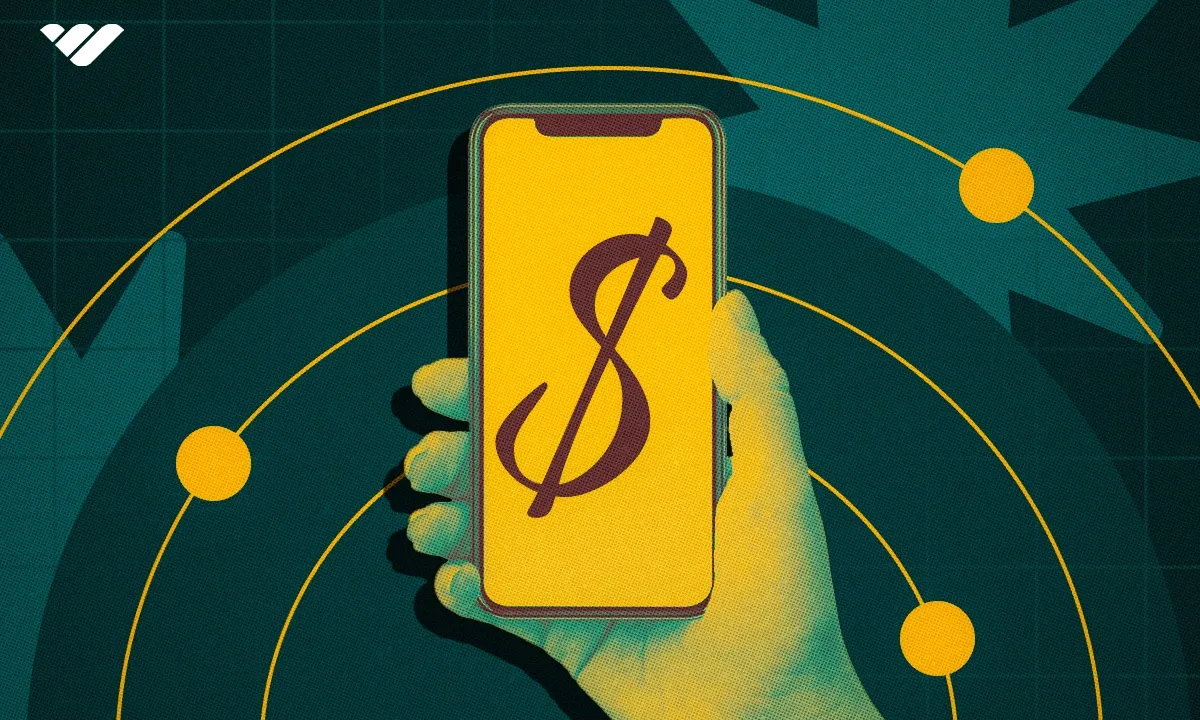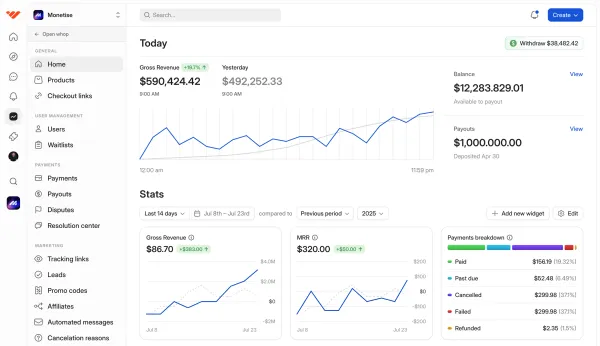Discover the secrets to starting a subscription business. From curation to access models, learn how to create steady monthly revenue and grow with Whop.
Key takeaways
- The subscription industry reached $3 trillion in value by 2025.
- Subscription businesses grow revenue 5-8 times faster than traditional models.
- Customer retention costs five times less than acquiring new customers.
- Three main subscription models exist: curation, replenishment, and access.
- Hybrid models combine subscriptions with traditional sales for revenue stability.
Starting a subscription business can provide you with a stable income and a convenient offering for your customers. The booming subscription industry is worth $3 trillion as of 2025, with 40% of its revenue coming from digital subscriptions.
Getting guaranteed cash rolling in every month is the dream. So, we get why you’re here.
In this guide, we’ll show you how to get started and choose the ideal subscription model. All of this is possible on Whop!
Let’s get into it.
How a subscription business works
Subscription models see customers pay on a recurring basis, in exchange for products or services. It can be weekly, monthly, quarterly, or even annually.
You’ll be familiar with them in some form - maybe from your internet provider, Netflix, grocery delivery, or something like Uber One.
The top three reasons that people pay for subscription services are, liking the subscription, reasonable pricing, and convenience.
Businesses also love them as they can secure ongoing revenue, while also strengthening customer relationships.
Why start a subscription business in 2025?

So why are 80% of digital businesses reporting that subscriptions are their most important revenue stream?
They grow fast
Statistics show that subscription businesses grow revenue 5-8 times faster than traditional business models — making them a great way to make money online.
Plus the average customer lifetime value is 5 times longer than traditional businesses.
Recurring revenue
Imagine you have 100 subscribers paying $10 per month. That’s $1,000 of guaranteed income every month.
This consistency allows you to predict your business growth with extra accuracy, so you can plan ahead and invest with more confidence.
It’s also far less stressful as a business owner to know where next month’s income is coming from.
More attractive pricing
Subscriptions can make products and services more attractive and affordable for customers.
For example, Amazon’s delivery fees can add up fast. It can be off-putting.
But, its Amazon Prime subscription offers free delivery. So, consumers save money on delivery. For Amazon, it works out as it encourages the customer to order from them more frequently and less elsewhere.
Improved cash flow
Have you ever seen when businesses offer annual subscriptions for a lower price than 12 months of monthly subscriptions?
That secures extra cash for them upfront, helping them to improve their cash flow and start growing with minimal external investment.
Improved service
With a consistent and loyal customer base, you can start to improve your service with deeper insights into what customers want. You can even start to personalize your experiences.
Plus, repeat customers are more likely to pay for extra costs, such as exclusive content and one-time deals.
Cheaper customer retention
It’s around five times cheaper to keep an existing customer than it is to gain a new one - because the need for marketing is less.
Subscriptions, by their nature, use existing customers on a recurring basis. That also increases their customer's ‘life’. You can gain far more revenue per customer, compared to a one-time or infrequently purchasing customer.
It’s your buffer
Subscription services become a buffer when the rest of your business is hitting a difficult period.
If your digital product sales are low, you can count on your subscriber income to maintain the business until you recover.
Types of subscription business models
To get started, you first need to choose a subscription model. They can be defined by three core types:
- Curation
- Replenishment
- Access
Curation subscriptions
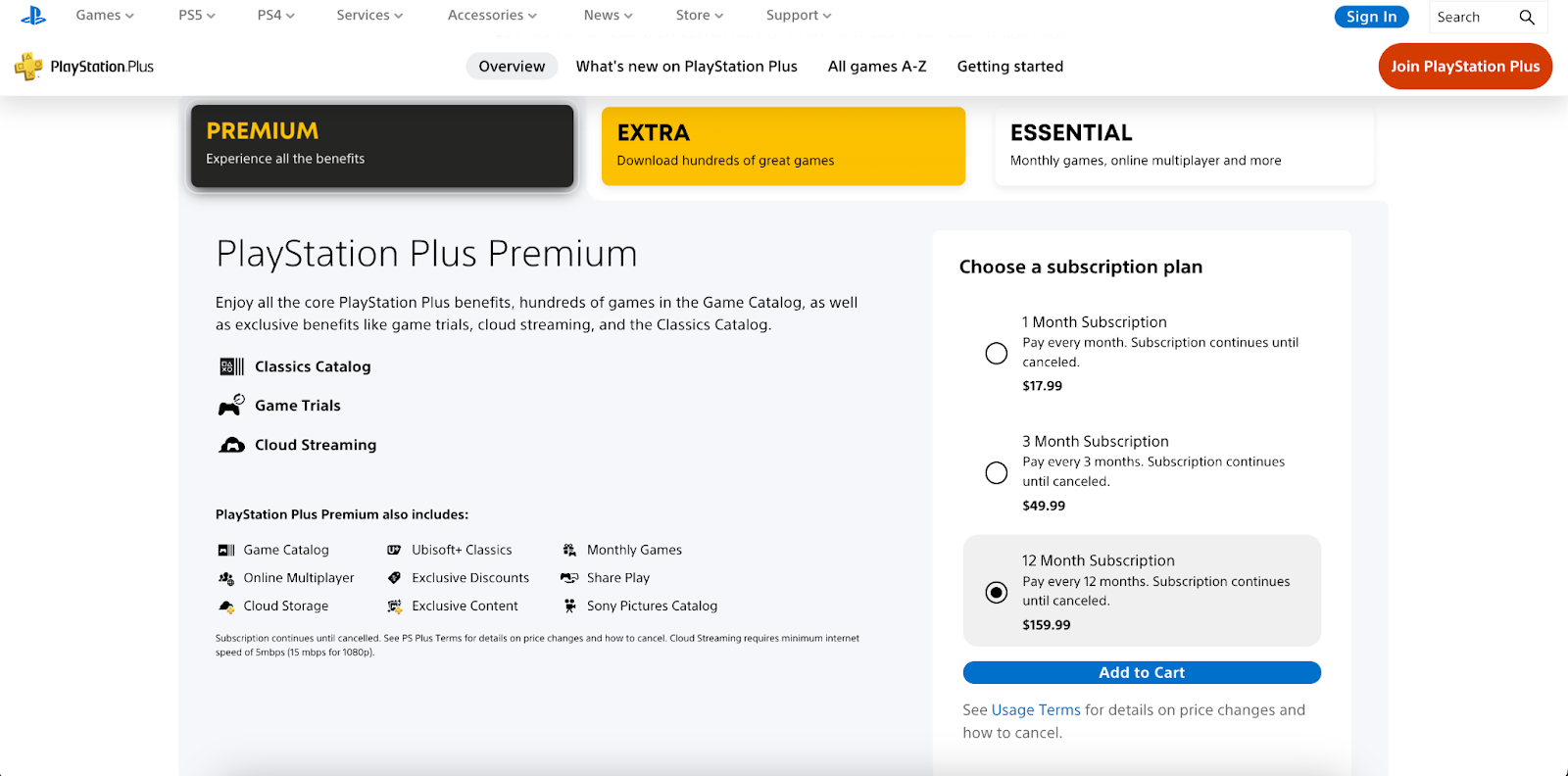
Curation subscriptions give the customer a selection of products, carefully chosen by the business. The customer trusts the business to provide good value for their money.
A famous example is Sony's ‘Playstation Plus’ subscription. Every month, subscribers get access to 3-5 games that Sony believes they’ll enjoy.
The curation models also work great for niches where the customer wants to get a fresh experience every month. For example, a snack box.
On Whop, you could use a curation model to sell curated courses every month on your chosen topic. Such as featuring special guests, or insights on particular skill sets.
| Pros | Cons |
|---|---|
| High-profit potential | Customers may lose interest if curation isn't exciting |
| Flexible product offerings, which can be very attractive | Often seen as unessential subscriptions |
| Customer loyalty | Ongoing product or service development is required |
Replenishment subscriptions
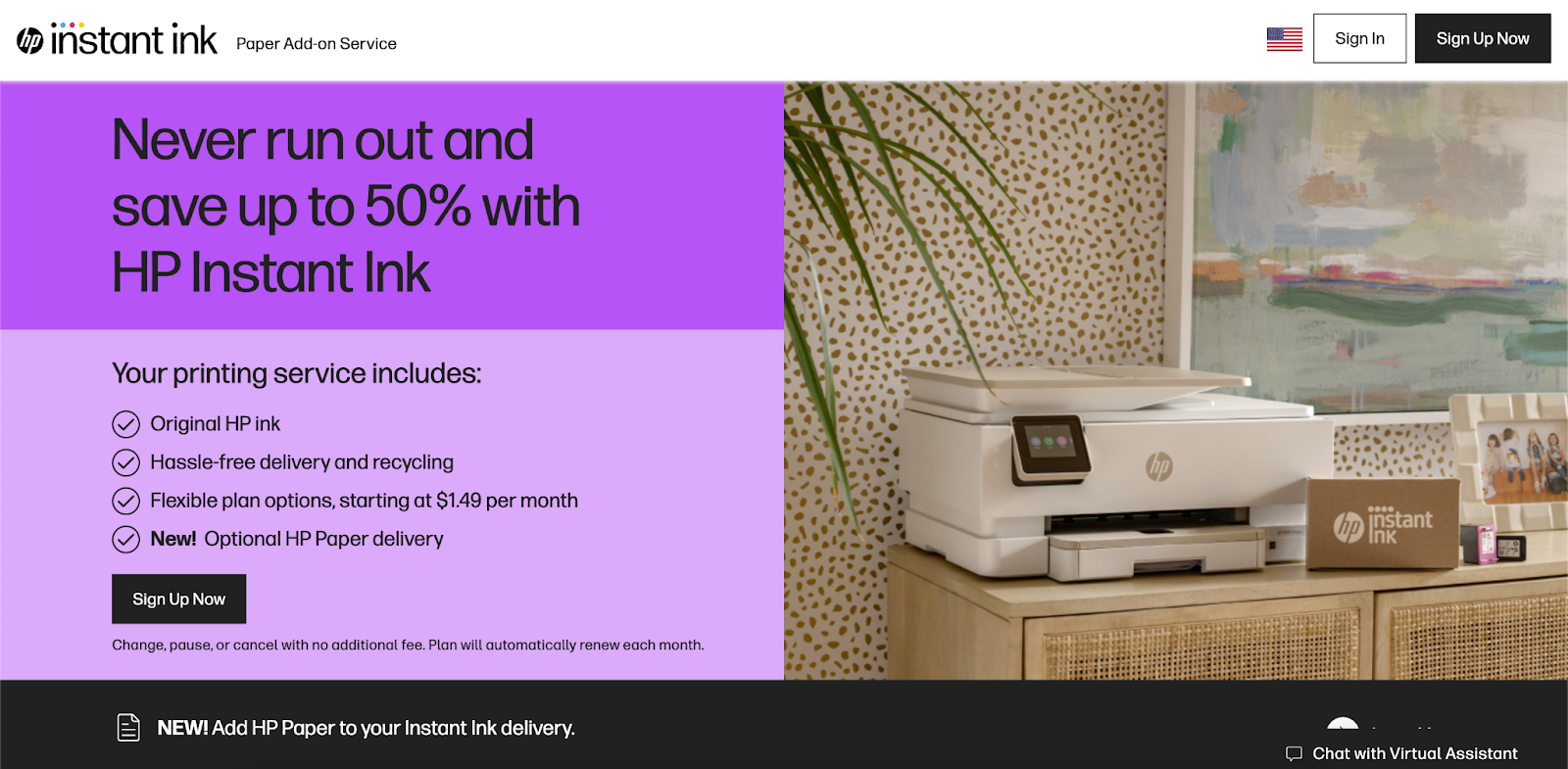
The Replenishment model gives customers an automated top-up and supply of their chosen products or services. It’s all about convenience.
For example, HP - they ship out printer ink cartridges to their customers when ink is running low. So the customer doesn’t need to worry about checking when it’s time to order more.
It’s a great option if your business is focused on convenience, such as providing critical products to a business or household.
In the digital space, Roblox Premium is a famous example, providing a recurring amount of Roblox currency per month.
| Pros | Cons |
|---|---|
| High conversion rate, as it's often a necessity. | Only applicable to a limited range of products and services. |
| Long-term subscription rates. | You may reduce profit margins, against single purchases. |
| Easy to please your consumers. | Can be seen as exploitative by some customers. |
Access subscriptions
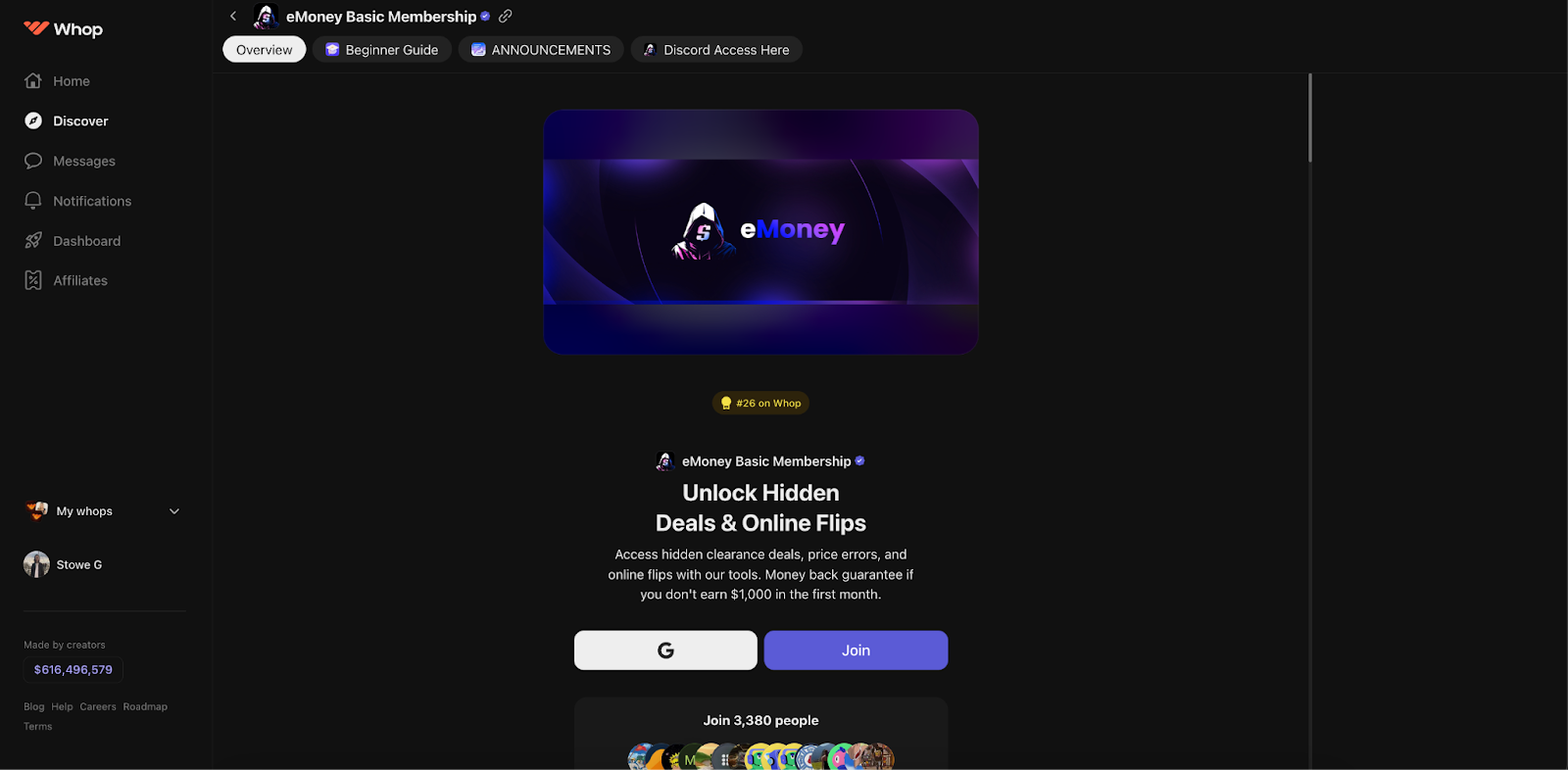
Access subscriptions give subscribers access to content, products, services, and perks that are otherwise inaccessible. The sense of exclusivity is what drives this subscription model.
They’re very common in the digital product world, as they’re great for businesses that want to use paywalls, like e-learning and paid communities.
One of Whop’s best-sellers is an access subscription that provides tools and strategies to unlock deals online.
| Pros | Cons |
|---|---|
| Create strong customer relationships | Exclusive offers and perks must be attractive enough |
| Create member communities | Costs may increase as you need to meet expectations |
| Sell premium services to existing customers | Uptake can be slow, so free trials or tiers may be required. |
Hybrid subscriptions
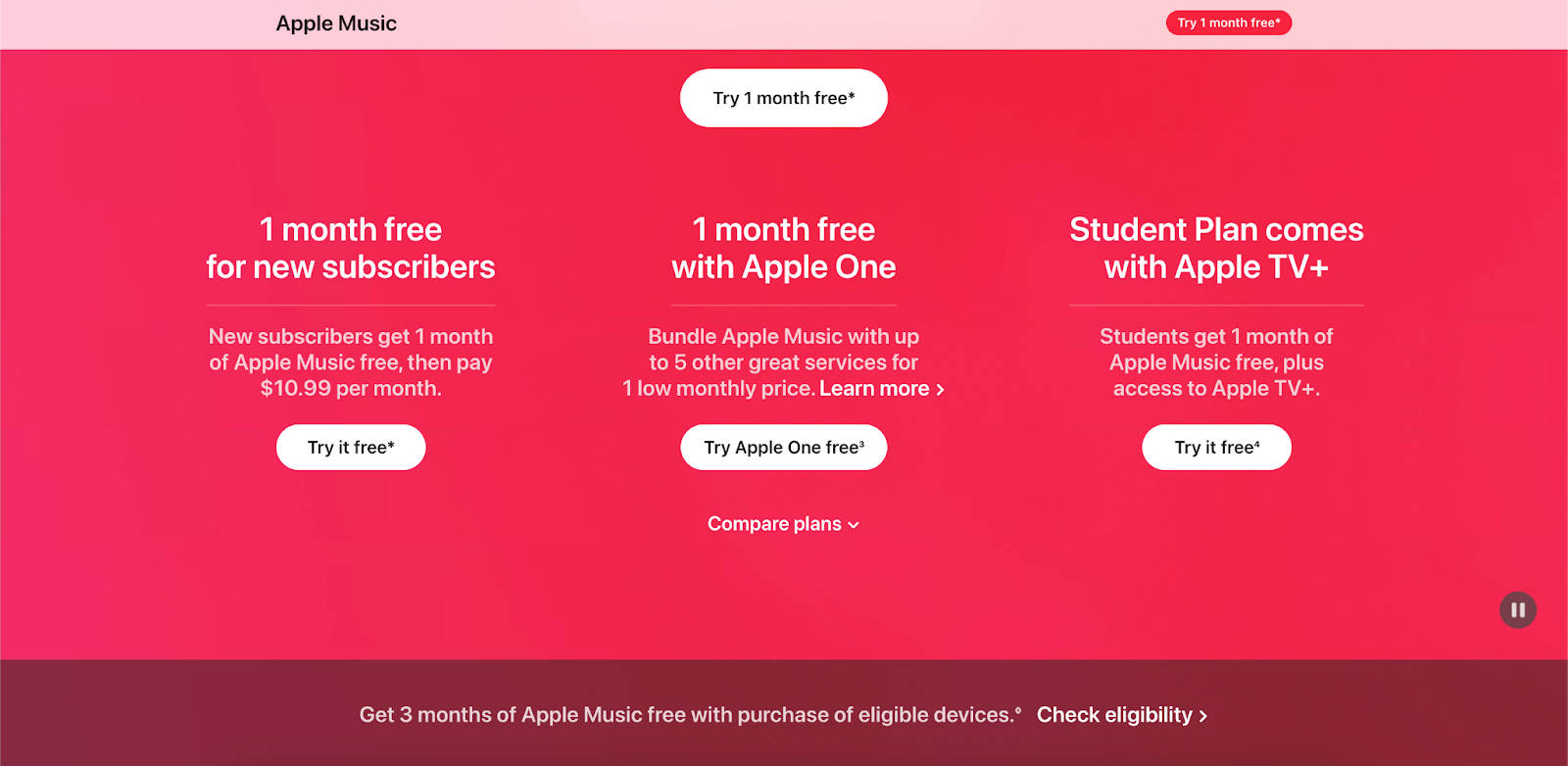
Hybrid subscriptions blend subscriptions into the more traditional way of selling. It may be your wisest route to take, as you won’t rely on a single revenue stream.
For example, you could sell digital products, with premium versions (or more attractive models) given to subscribers only. You could even combine all three subscription models to create a wide and attractive selection for your customer base.
Apple Music uses this model well, offering people the chance to buy albums upfront, but also to subscribe to stream music without purchasing it.
| Pros | Cons |
|---|---|
| Lots of flexibility to experiment. | An added layer of customer support and sales, which can get complicated. |
| Additional revenue stream to stabilize your income. | It may complicate your marketing and brand understanding. |
| Attract multiple types of customers. | Difficult for businesses with limited product range. |
How to choose the right subscription model for your business
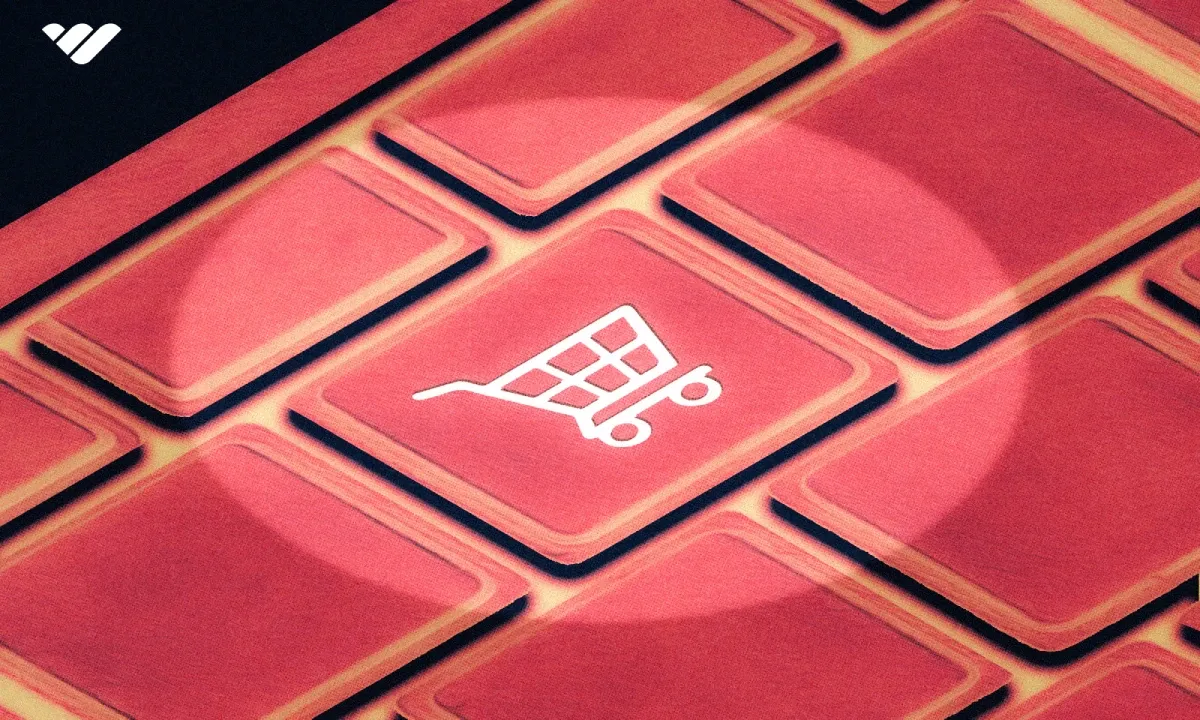
Choosing the wrong subscription model can see you wasting time trying to correct the course. Think carefully.
Which model suits your product?
Imagine you’re running an e-learning business. An access model will make sense if you want to provide access to courses, materials, and a community. But a curation model would also make sense if you want to offer fresh monthly content.
Mix with the Masters is a great example of this. They provide fresh video content from professional music producers every month - so subscribers get insights every month.
But that might not be possible for you. So, you need to think about what is actually practical.
Also, think about whether you can satisfy your customers over a long period. Does your model provide a reason to pay month after month?
If you have a large number of products then a curation model could work. But, if you’ve got a limited number of products it likely won’t and may be better suited to an access model, with features like a paid community or chat.
Is there demand?
The subscription industry is worth over $3 trillion. So it’s fair to say some niches are overwhelmed by competition.
Ask yourself if there is a demand for the type of subscription and product combination you want to use. Do some market research to see if it works with competitors. And if so, what are they doing right? What could you do to improve upon their service?
You may also need to consider more attractive pricing to get started if your market is saturated.
Which fits your values?
Some customers may see a replenishment service as exploitative. Logitech, for example, hinted at a subscription service to use their computer mouse. It didn’t go down well with tech consumers.
Consider what can build a strong relationship, rather than create a hurdle. Access models are particularly good at building relations, as they usually involve community and exclusive customer support.
How to get started with a subscription business
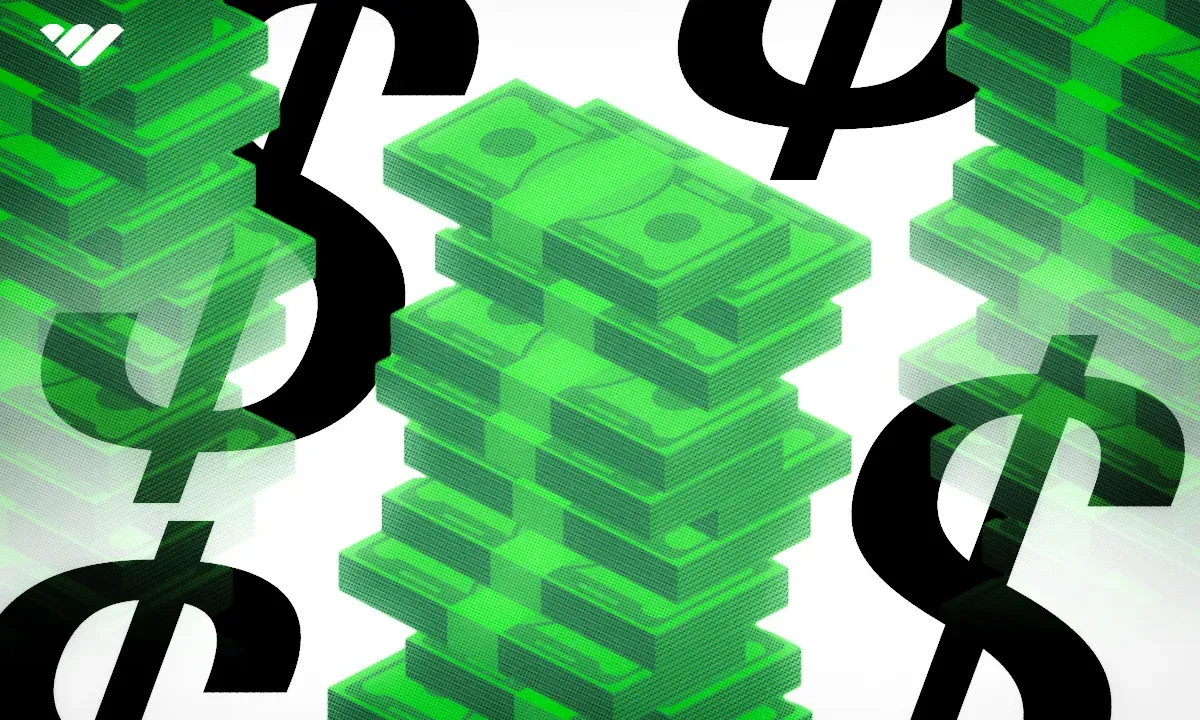
Create a product idea
What are your products? If you already run a business, consider which of your existing stock or services would be suitable for recurring payment.
If you’re starting from scratch, or want to sell new ideas, think about where the demand is in the market for a recurring product or service.
Doing some market research by running surveys, social media polls, or assessing competitors may give you some data-backed ideas.
Creating the product is fun, but time-consuming! Factor this in before you announce any release dates.
Common examples of products include:
- E-learning materials and courses
- Access to media, such as games, gaming mods, video content, and music.
- Software and apps
- Digital tools
- Data and analytics
- News and information
Plan your subscription
Once you’ve decided on your core model, it’s time to decide what precisely the customer will get per month.
If you’re running a curation model, you should plan out several months in advance to give you time to come up with new ideas in the future. It will also allow you to advertise what future subscriptions will include.
You can also consider reaching out to brands that may want to partner with you, by including their products in your subscription.
If running a replenishment model, think about the quantity of products your customers will get per month. It needs to be an attractive amount and make sense for you and the customer financially.
If running an access model, plan what the customer gains access to. Many people include various perks alongside the core product or service, such as Discord chats, forums, discounts, and exclusive merch.
Plan your pricing
Now you know what you’re going to sell, you can determine your pricing. You'll need a fine balance between keeping it attractive and realistic but still achieving your profit margin goals.
Calculate your costs, by deducting the price of the products (such as development, labor, manufacturing, and delivery) and any marketplace fees.
Then you can calculate the appropriate pricing, based on your profit margins. Remember to factor in your market research, including competitor pricing.
Consider different tiers
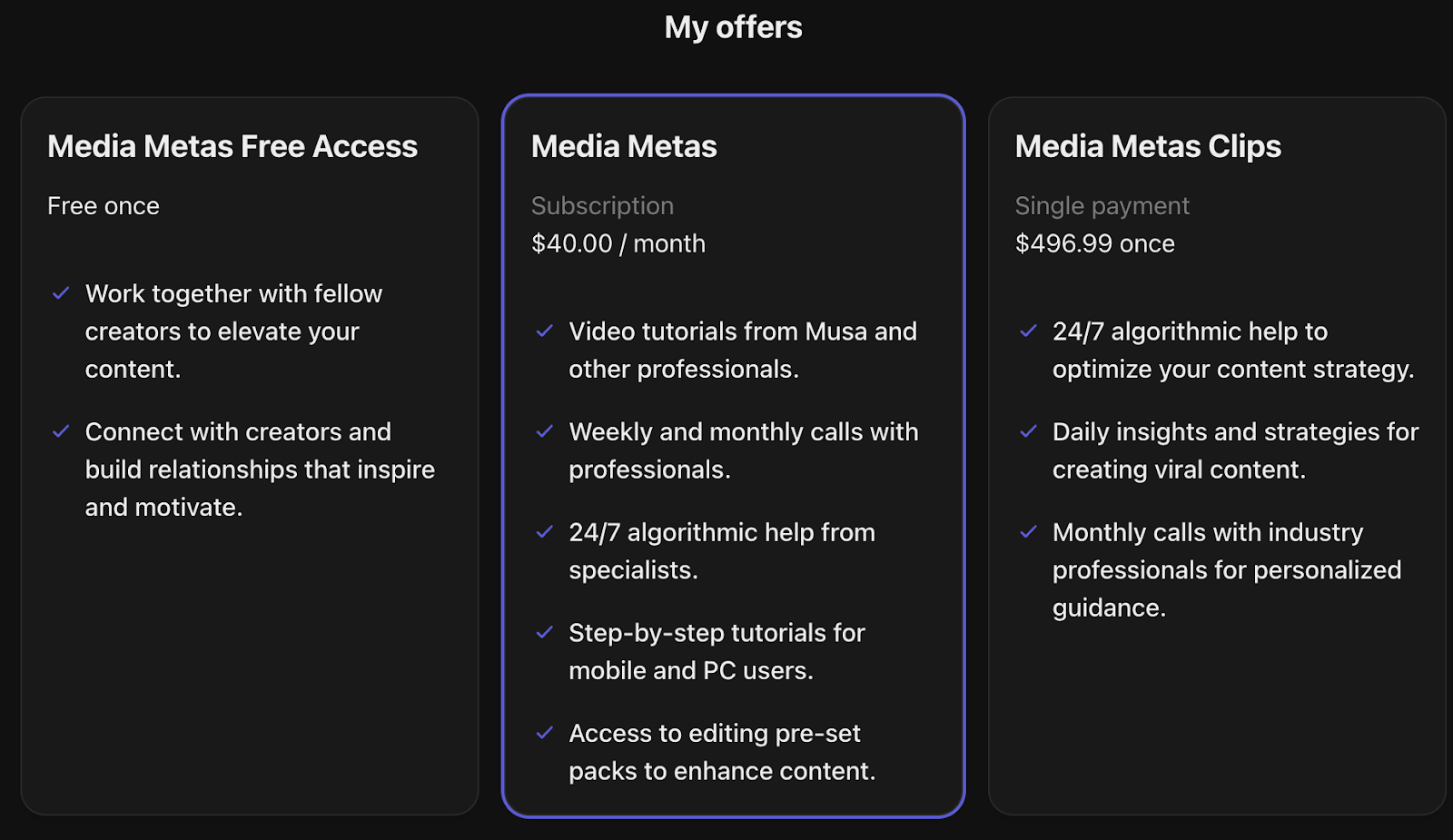
You can also consider adding different levels of subscriptions and memberships, with each one offering more in exchange for a higher price.
This is a great way to attract different demographics and bring in extra revenue from big spenders.
For example, Media Metas are on Whop and offer three different packages of social media advice and consultations. The first one is free, helping to draw in a customer base.
Then, extra features are added monthly.
Choose your sales platform
Where you host your subscription service could be the difference between success and failure. While you can host your service on your own website, you’ll need advanced web development skills to include the variety of apps and features that many modern services provide.
The best thing to do is choose a platform designed for subscription-based selling.
Whop makes it very easy, with a large variety of apps from files and Discord integration, to custom apps and course systems. You can manage your whop from your desktop or mobile app.
Payment is also all processed on your whop, making it the easiest way to start a subscription business. You can accept multiple currencies and even cryptocurrency!
Market your business
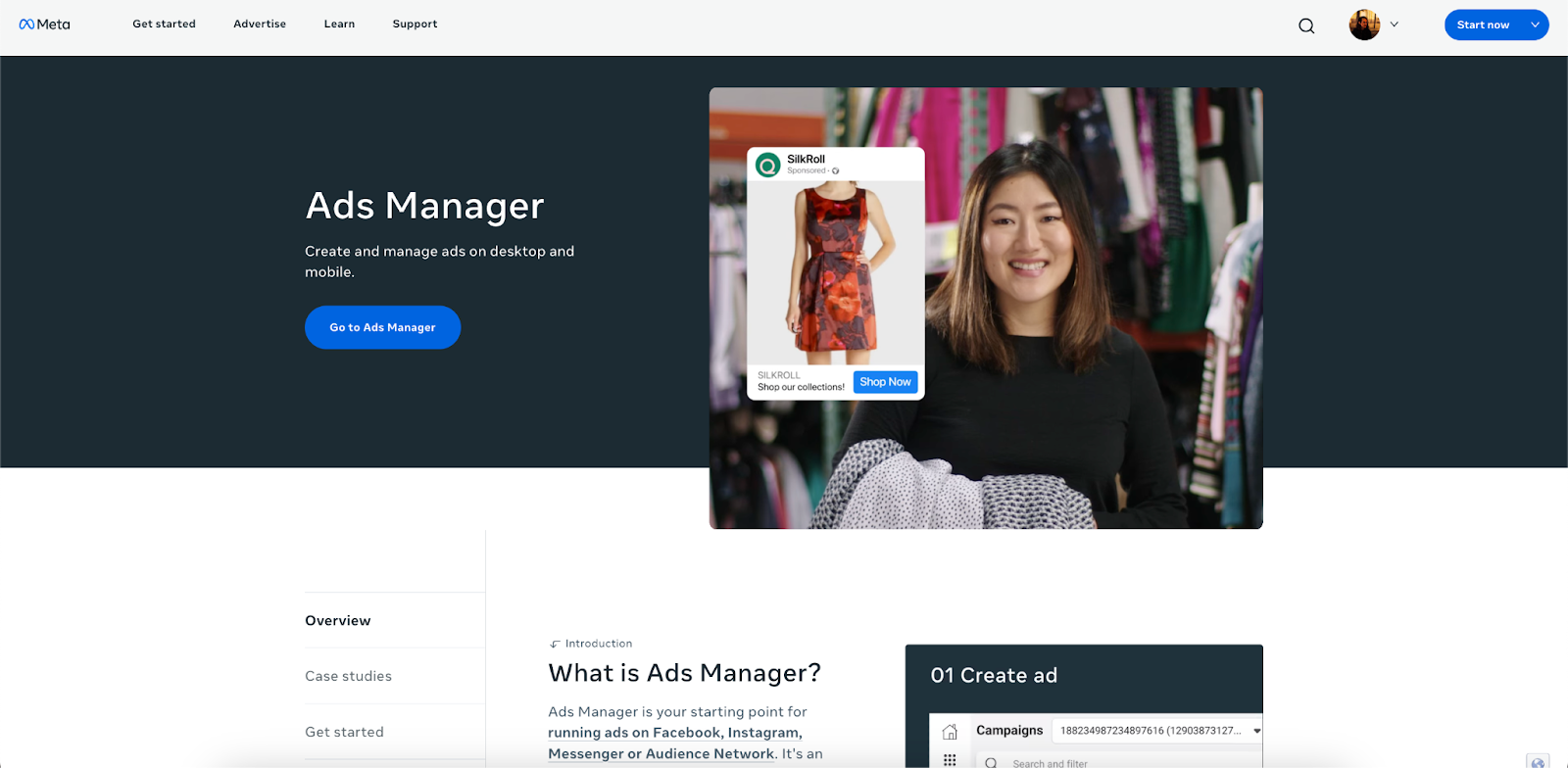
It’s time to let the world know all about your new subscriptions!
Whop will display you to customers on the Discover page, but you should go further with marketing.
Stats show that email marketing and social media are the most successful sales channels. If you have a pre-existing customer base, then you can send out emails advertising your new subscriptions.
Why not consider a discount, or first free month, to your most loyal customers?
Social media is, of course, a necessity. Create pages on Facebook, Instagram, and TikTok, to share teasers on your products and offerings. You can also consider using affiliate marketing, user-generated content, and influencer or brand partnerships to help increase your exposure.
Running adverts is also an essential way to get your brand seen before new eyes. Google Ads, Meta Ads, and TikTok ads are all easy to get started with and can work to a predefined budget.
You can also write a press release. Then, publish it on your site, and send it to blogs and sites that may be keen to review your product.
Finally, run some giveaways to get people interested. Such as rewarding your first 50 subscribers with free merch, or picking a random winner from anyone who likes your announcement post!
Create a brand image

Branding is extremely important when it comes to subscriptions - because it’s the brand, rather than just the product that customers are paying for.
Create a memorable brand name, color palette (that reflects the vibe), and slogan. Use your brand image consistently from Whop to your site, and from TikTok to your subscription itself.
Read our guide of the best personal branding examples.
How much does it cost to start a subscription business?
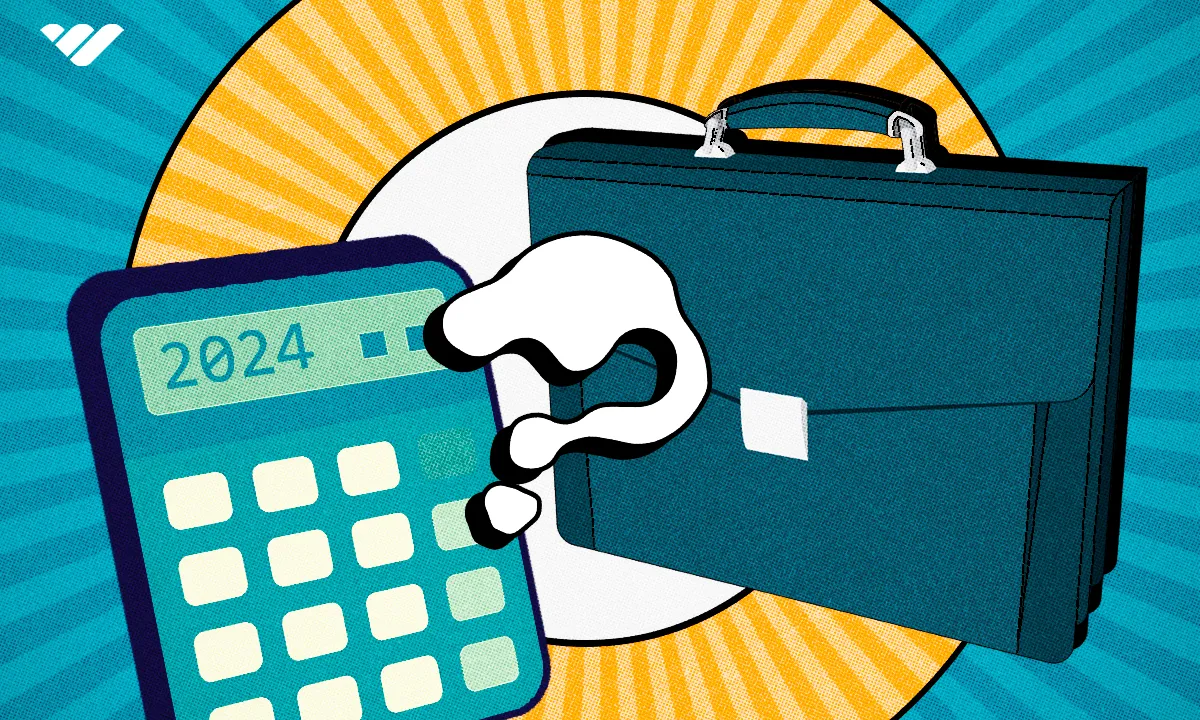
With any business, there will be expenses to think of and factor into your pricing strategy.
Product costs
Products will be your number one cost. Thankfully in the digital product niche, there aren’t any manufacturing costs.
But, you may still need to pay development costs, including freelancers who helped you build the product, software fees, hardware costs, and testers.
Marketplace and website costs
Selling your subscription business online can be very cheap, but rarely free.
Even when selling your products on your own site, you'll need to pay for the development of your website, domain registration, and hosting fees.
Ecommerce platforms also come with costs, but the good news is that Whop demands $0 upfront. You only pay when a sale is made (as it’s taken from your revenue).
Marketing costs
Social media ads, Google ads, affiliate marketing, influencer partnerships, and other digital marketing routes all come at a cost. Some people factor this into their pricing, while others will invest some cash upfront.
Any promotional deals or discounts may also impact your profits and be worth calculating.
If you’ve got strong social media skills, you can significantly reduce your marketing costs by handling it yourself for free.
Overhead costs
Digital subscription overhead costs are typically pretty minimal. But if you’re renting an office space or paying any freelancers or employees, then always factor them into your pricing model.
It’s also worth considering if these costs will increase as your subscription service grows. For example, if you start selling merchandise, what costs will there be?
How to start a subscription business on Whop
Here’s a quick step-by-step guide on how to start your subscription business for digital products on Whop.
1. Sign up
Signing up is simple. Just head to the homepage at Whop.com and click the big orange button that says, “Sign up”.
Once you’ve entered your details, click “Build your whop” in the top right of the screen.
2. Create your whop
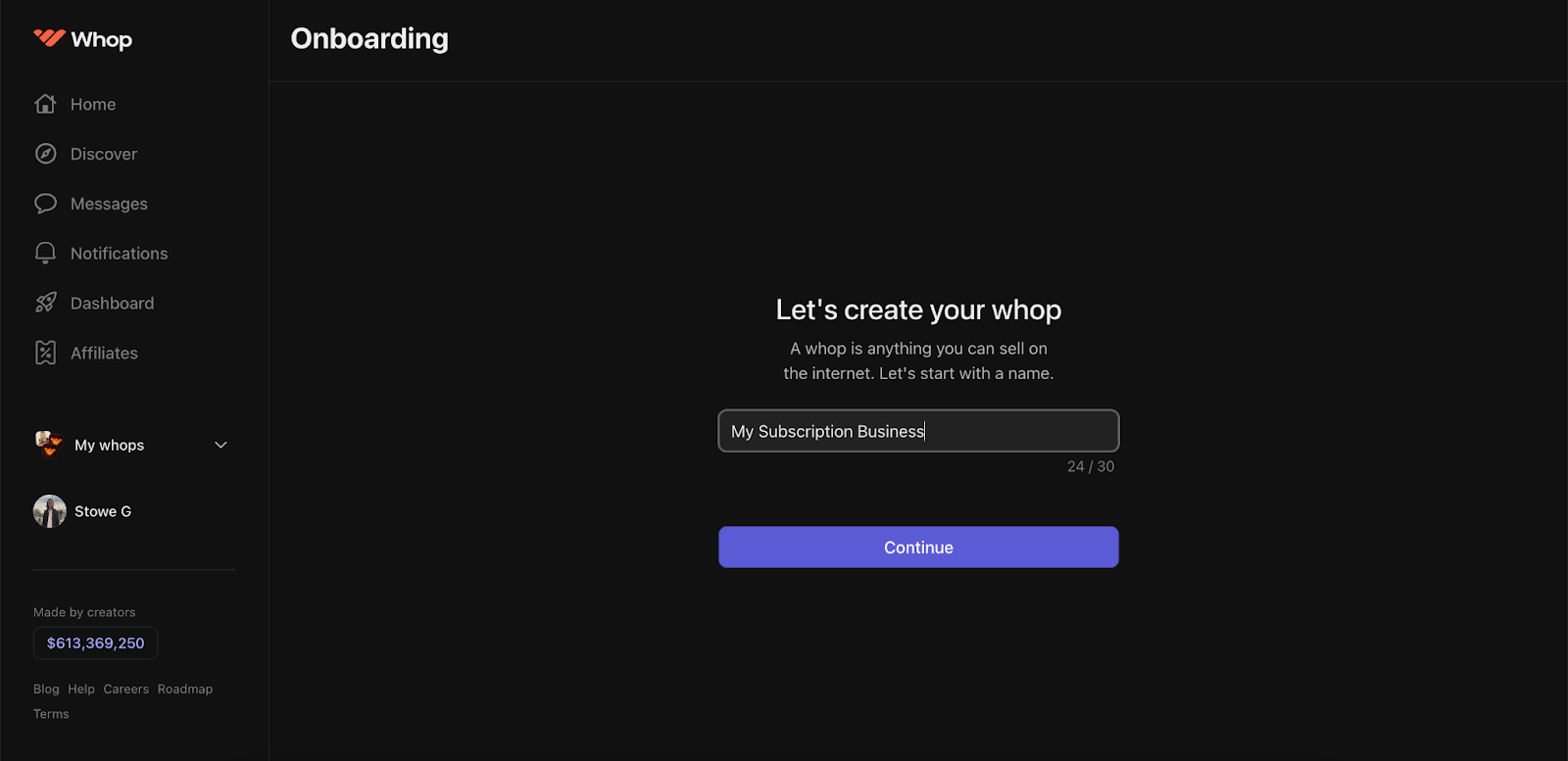
You’ll then be taken to the onboarding page. Click “Create a new organization” and enter a name. You can always change this later. Then, you’ll need to enter the way your whop will help people.
Wait a few seconds and wow, your Whop is ready to start fine-tuning!
3. Set your whop as a subscription service
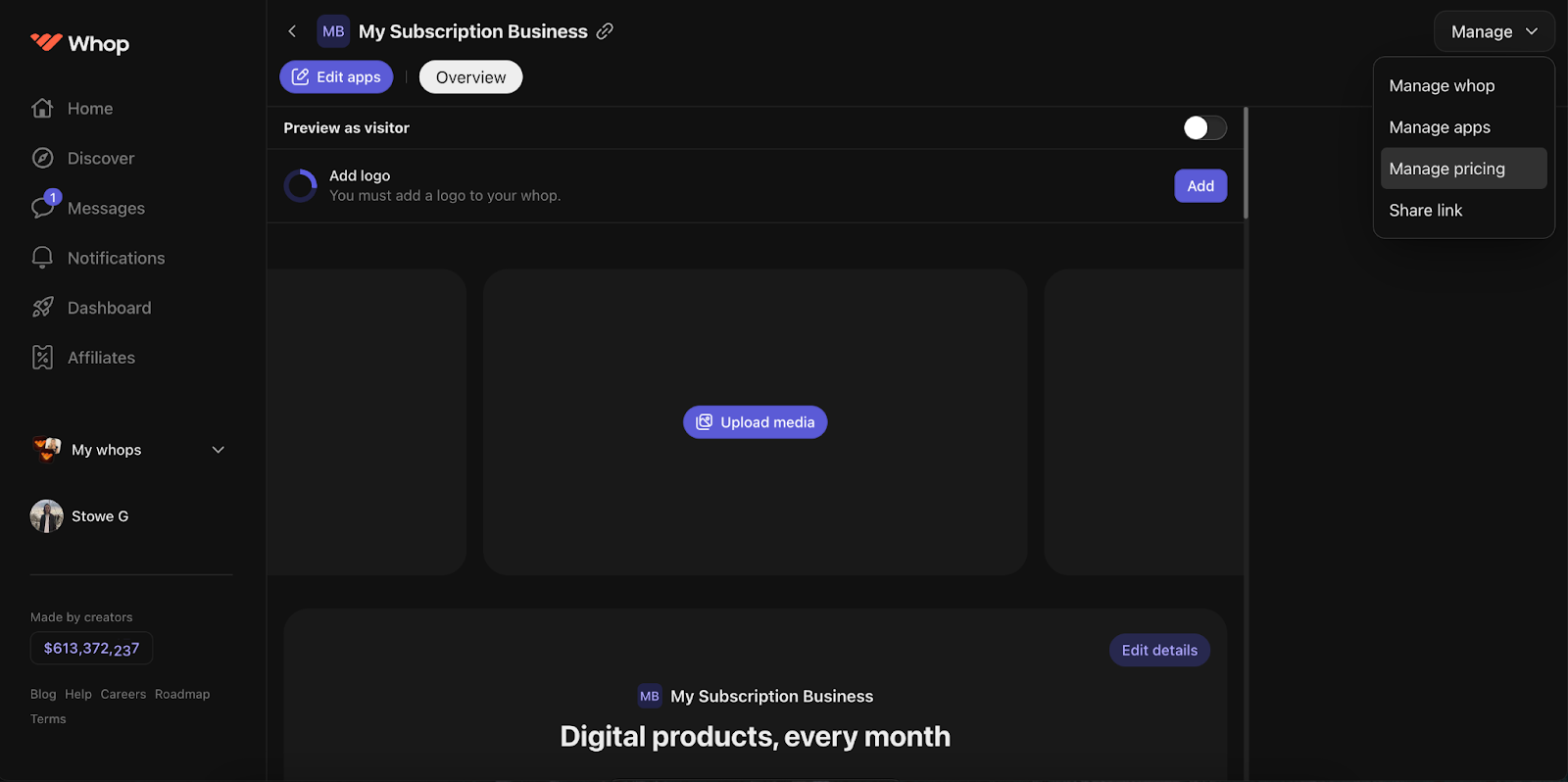
Once taken to your whop page, click on “Manage in the top right” and then “Manage pricing”. This will allow you to set the page up as a subscription-only service.
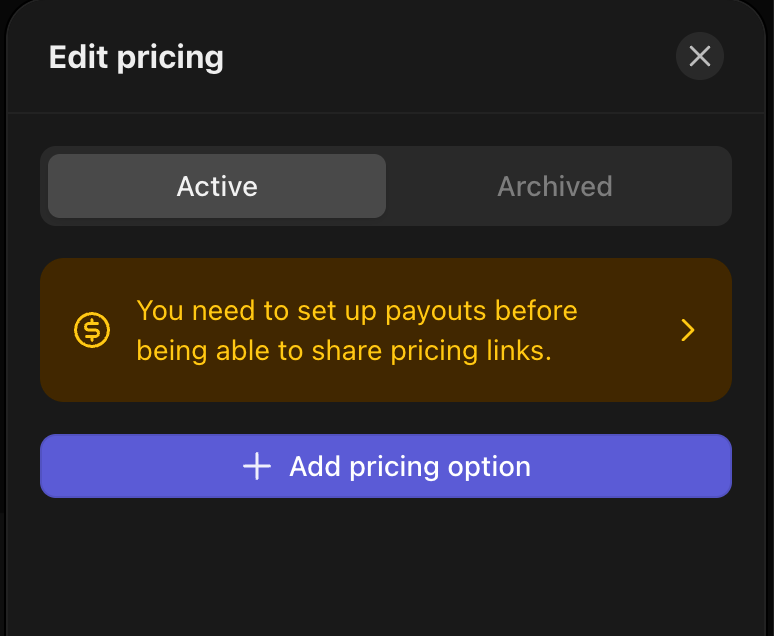
Click, “+ Add pricing option” on the panel that will appear on the right of your screen.
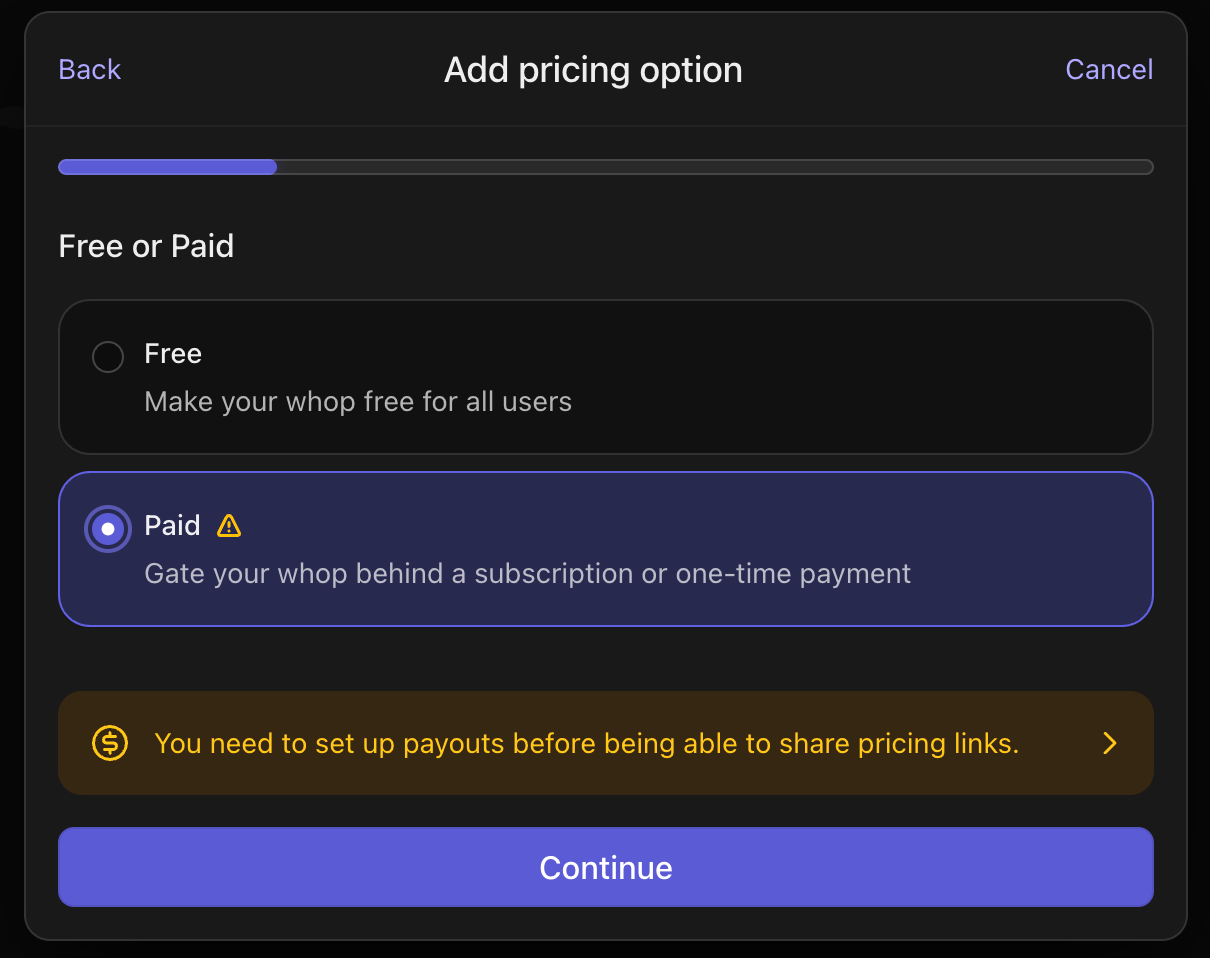
Then, click “Paid” and “Continue”.
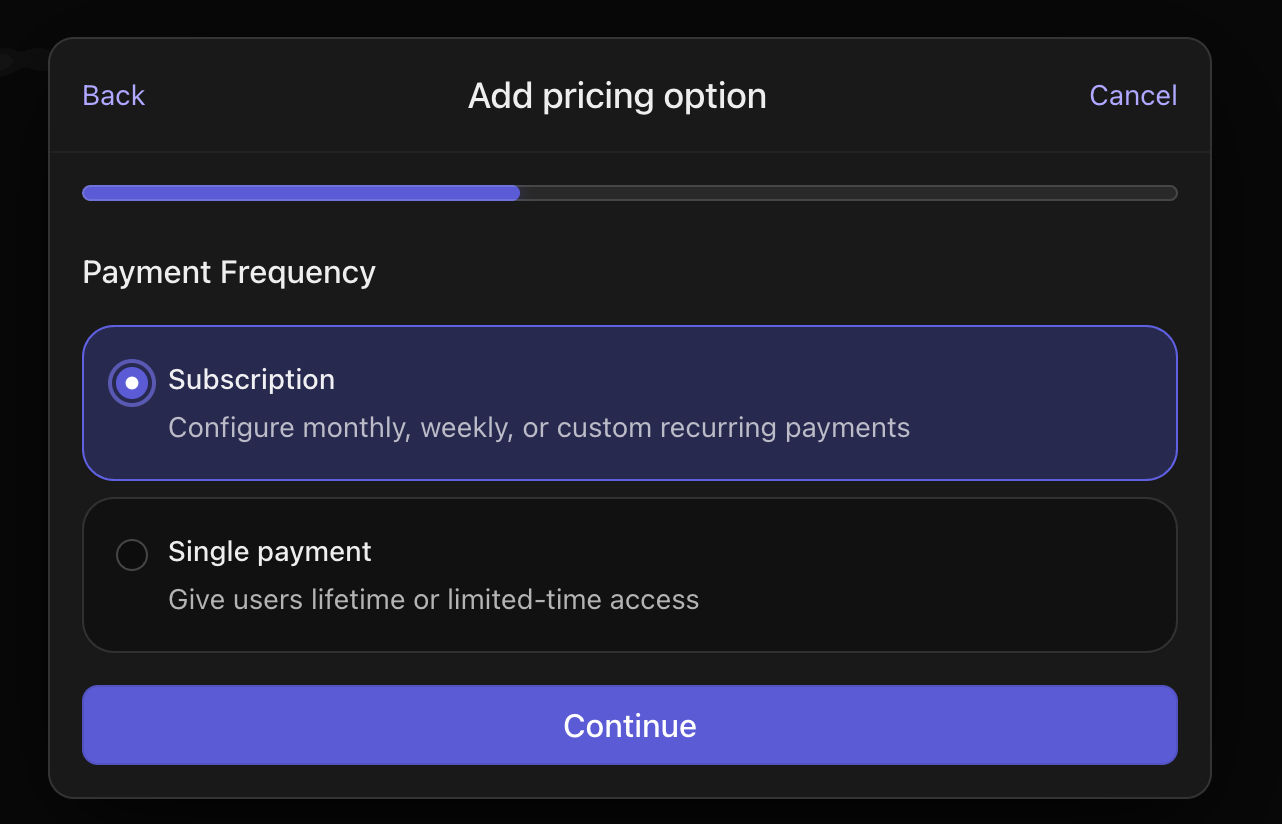
Then choose “Subscription”.
4. Customize your subscriptions
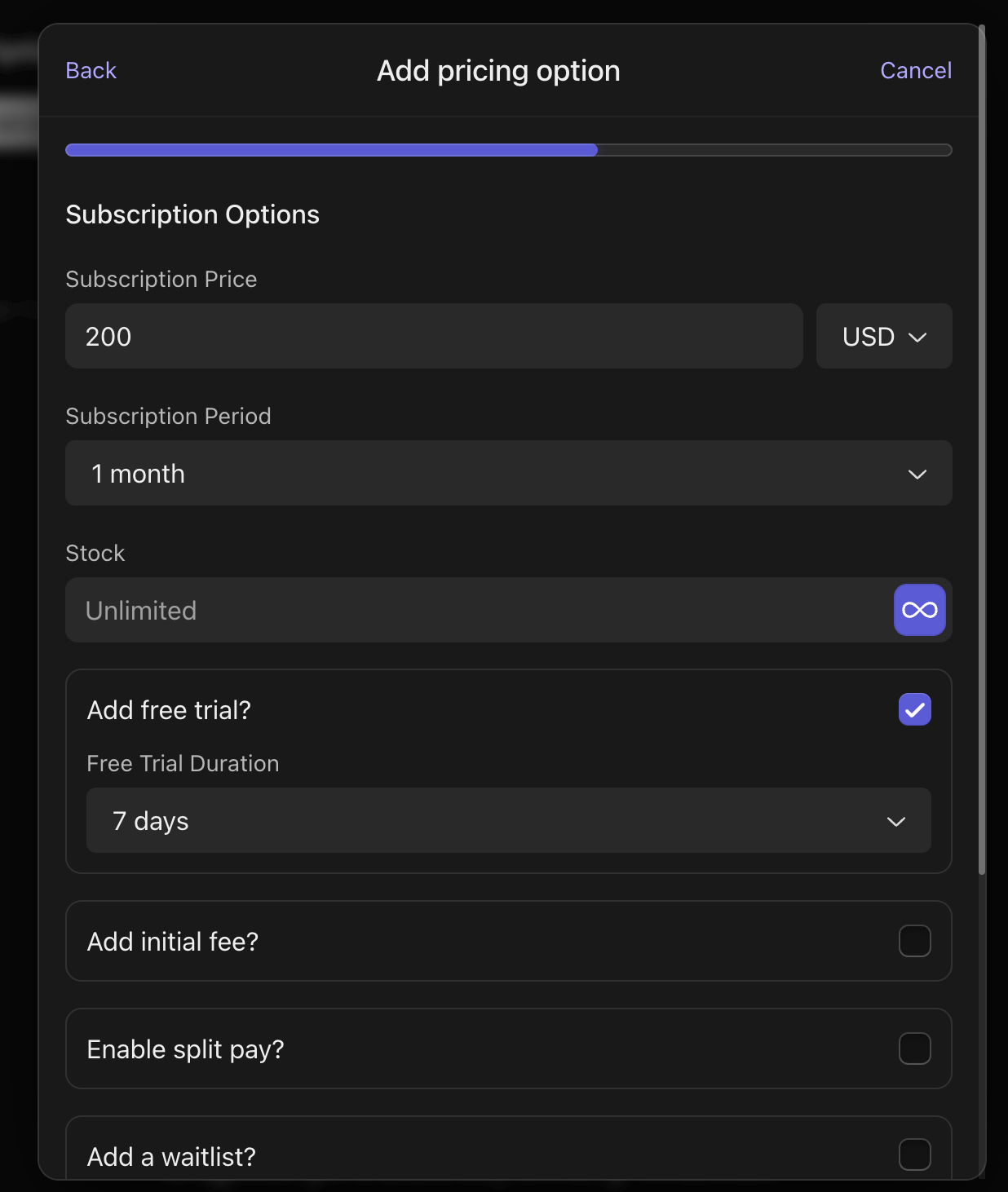
Now you can select the specific settings of your whop subscription business.
- Choose a price for access to your whop, with your preferred default currency.
- Use ‘Subscription Period’ to set how long a payment gives access to your whop.
- Use ‘Stock’ to limit how many people can subscribe.
- Use ‘Add free trial’ if you want to give a period of free use.
- Use ‘Add initial fee’, if you want subscribers to also pay an upfront cost.
- Use ‘Enable split pay’, if you want customers to gain lifetime access after a certain number of payments.
- Use ‘Add waitlist’, if you want to allow only accepted members to become subscribers.
- Use ‘Offer discount’, to provide a discount incentive to any customers who try to cancel their subscription.
You’ll then be prompted to choose if you want the subscription to be public or private.
5. Adding apps to your whop subscription business
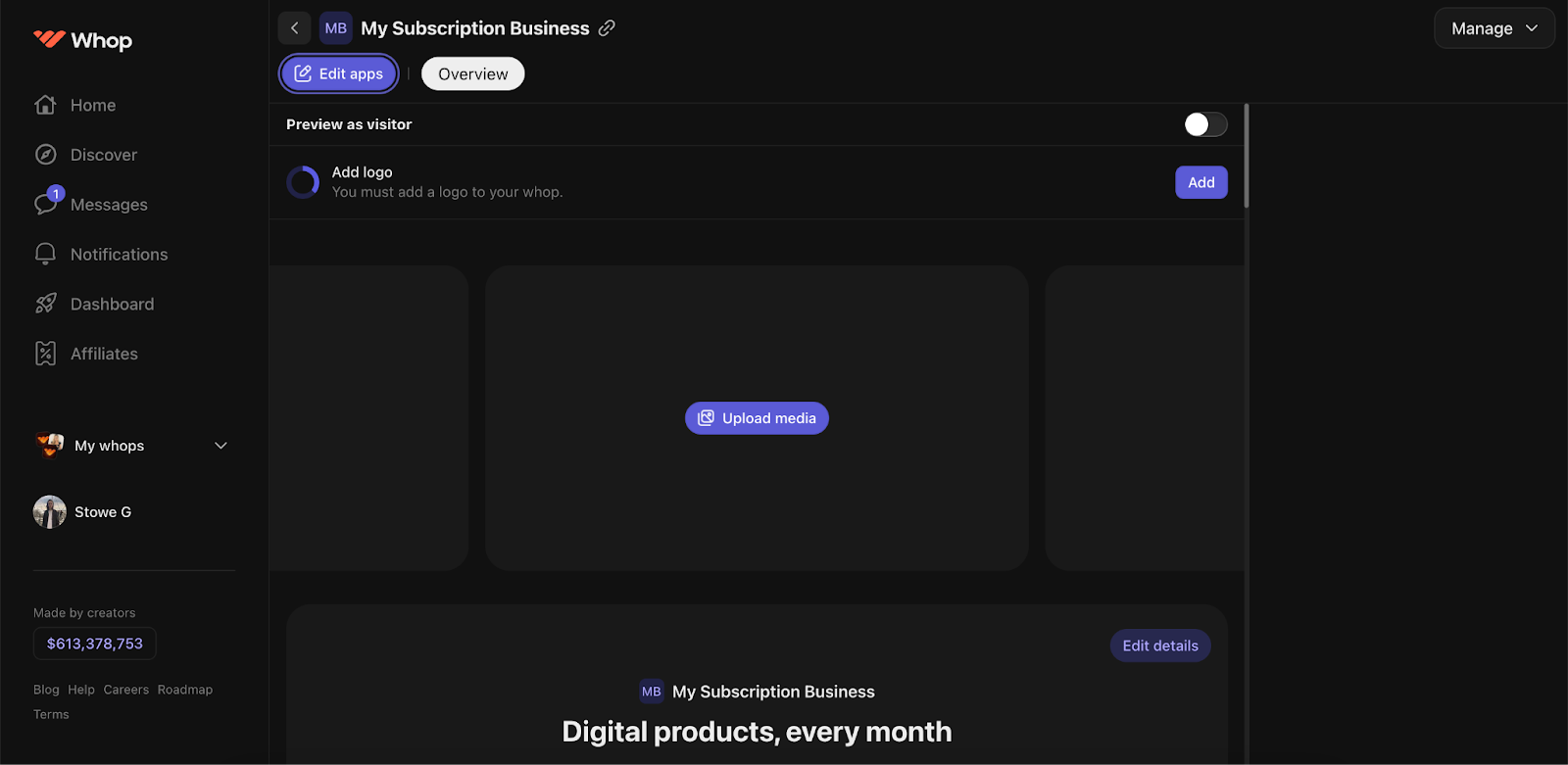
Click ‘Edit apps’ at the top of the screen to start adding ‘apps’ to your whop. Then select ‘Add new app’.
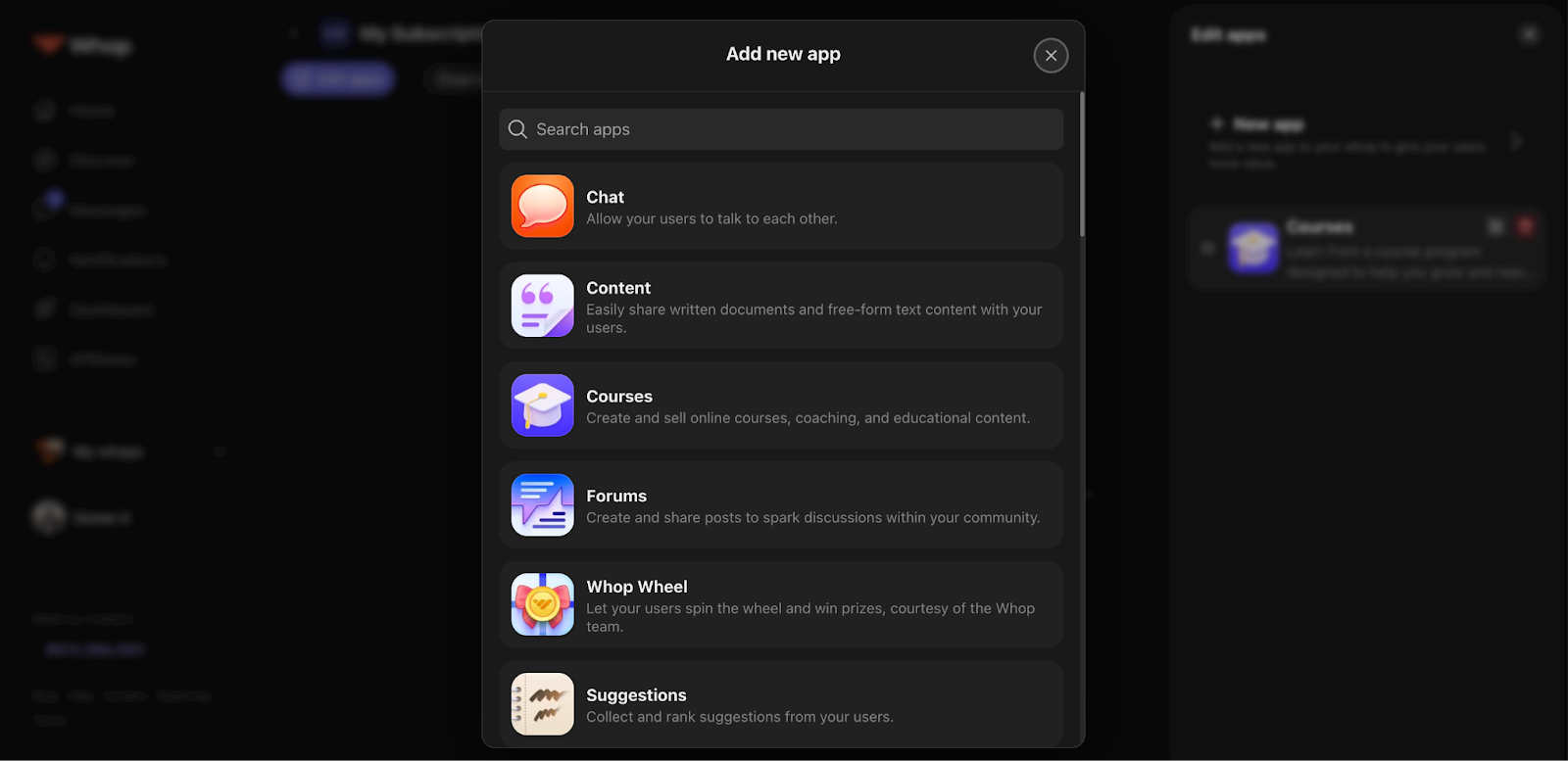
Apps are the features that your users will get access to. As you can see, there are plenty to choose from. You can even use HTML to add and customize whatever you want.
You can add courses, digital products, files, content, Discord chats, web apps, and so much more! Feel free to play around with the apps, before launching your business.
You can start customizing your whop with logos, branding, descriptions, and FAQs. You can even add affiliates.
6. Using API
If you want to integrate third-party platforms within your paid community, then Whop’s got you covered. With a powerful API, you can automatically grant paying customers access to other services like Discord and Telegram. And it’s all manageable and trackable from your whop dashboard. Easy.
Examples of success on Whop
Her Last Call Academy
Alexis Seleste’s ‘Her Last Call Academy’ provides subscribers with coaching to help entrepreneurial women secure life-changing sales.
Her whop uses coaching calls, courses, forums, chats, events, and even a job board to help others excel. She has monthly and annual options and an admission to a Miami Mastermind event.
In just 27 days since launching her community, she raked in over $100k!
Alex Sedlak
Alex Sedlak owns two of Whop’s biggest communities, Media Labs and Print Money W TikTok.
MediaLabs uses a team that helps TikTok creators partner with brands to make promotional content. There’s an in-depth course that fronts what is effectively an agency.
Print Money W TikTok is all about helping people monetize the app from $0. There are samples, a Discord chat, and instant access to industry experts!
Sedlak has days where he makes over $200,000! Not bad...
Girl Boss Abroad
Natasha Ibrahim, founder of Girl Boss Abroad, has mastered the art of making lots of money while traveling the world. If you’re like me and thinking, “Damn. I should try that”, then check out her community.
The whop mostly sells services as a one-time offering but also uses a $10 paid newsletter, helping bring it extra revenue in exchange for some super insights and tips.
Things to think about before starting a subscription business
Do I need to register my subscription business?
If you start making money in the US, you must declare it with the appropriate government authorities for tax purposes. The last thing you want to do is get fined and ruin all your hard work!
Registering your business ensures it's recognized as a legal entity. You may need to register at a local, state, or federal level.
As annoying as this paperwork may seem, there are some nice benefits you can gain as a business owner, including liability protections - so if you ever got sued or had business debts, your own personal funds, and assets wouldn’t be at risk!
Sole proprietorship, Limited Liability Company (LLC), partnership, or corporation are the common business structures of choice.
- How to start a small business at home: step-by-step guide
- How to start an ecommerce business
- How to start a business (the blueprint to success)
Is a subscription business profitable?
Subscription businesses can be highly profitable, despite often selling products for less than they would be individually.
The trick is to create a pricing strategy and attractive offering that secures enough customers so that you’re guaranteed to make money every month.
Here’s a look at which subscription niches made the most money in 2024:
- Home and pet: Average of $332 per customer.
- Health and wellness: $325 per customer.
- Food and beverage: $323 per customer.
- Beauty and care: $256 per customer.
What type of subscriptions make the most money?
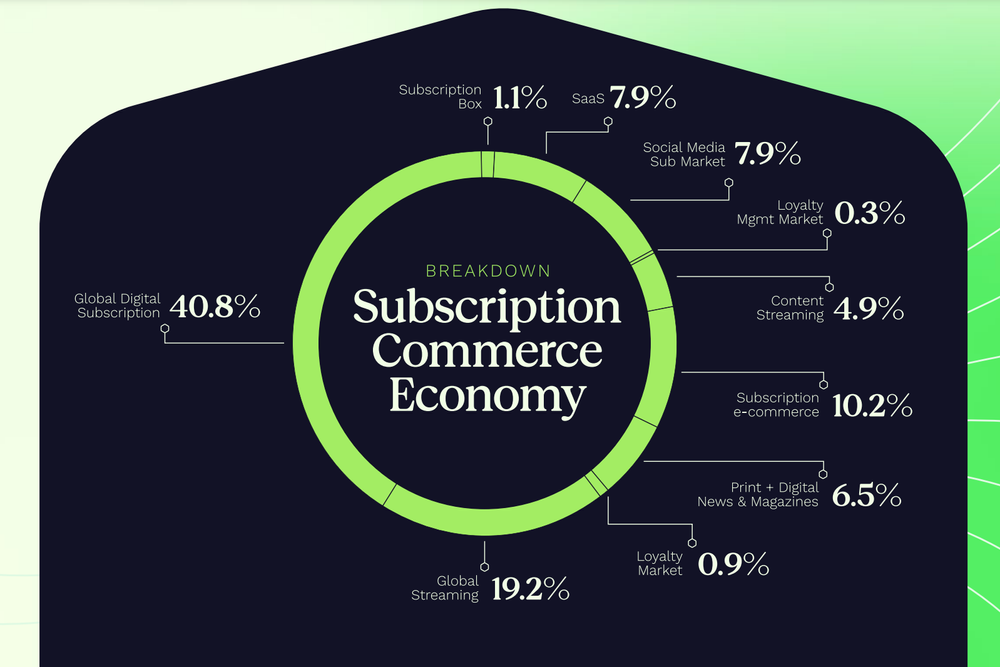
Here’s a breakdown of the subscription commerce economy:
- Digital product subscriptions: 40.8%
- Global streaming: 19.2%
- E-commerce: 10.2%
- Saas: 7.9%
- Social media: 7.9%
- Print and digital news and magazines: 6.5%
- Content streaming: 4.9%
- Subscription boxes: 1.1%
- Loyalty market: 0.9%
- Loyalty mgmt market: 0.3%
Read our subscription statistics guide for more insights.
Start a subscription business today with Whop
So, now you know what it takes to get started, it’s time to choose a place to sell.
Whop creators have made a total of over $615 million and that’s thanks to its game-changing digital product selling setup.
Now it’s your turn. It takes less than 10 minutes to get started.
Regardless of your niche, you can create a whop (which is a customizable hub) to shape your subscription service with chat rooms, forums, events, products, games, HTML apps and so much more.
You can even offer multiple tiers of subscriptions, from free to annual payments. Everything is all under one system, making it a breeze for both you and your customers.
Whop is also stacked with ecommerce and subscription gurus and guides to help you through the process.
So, what are you waiting for? Let’s go make some money!


